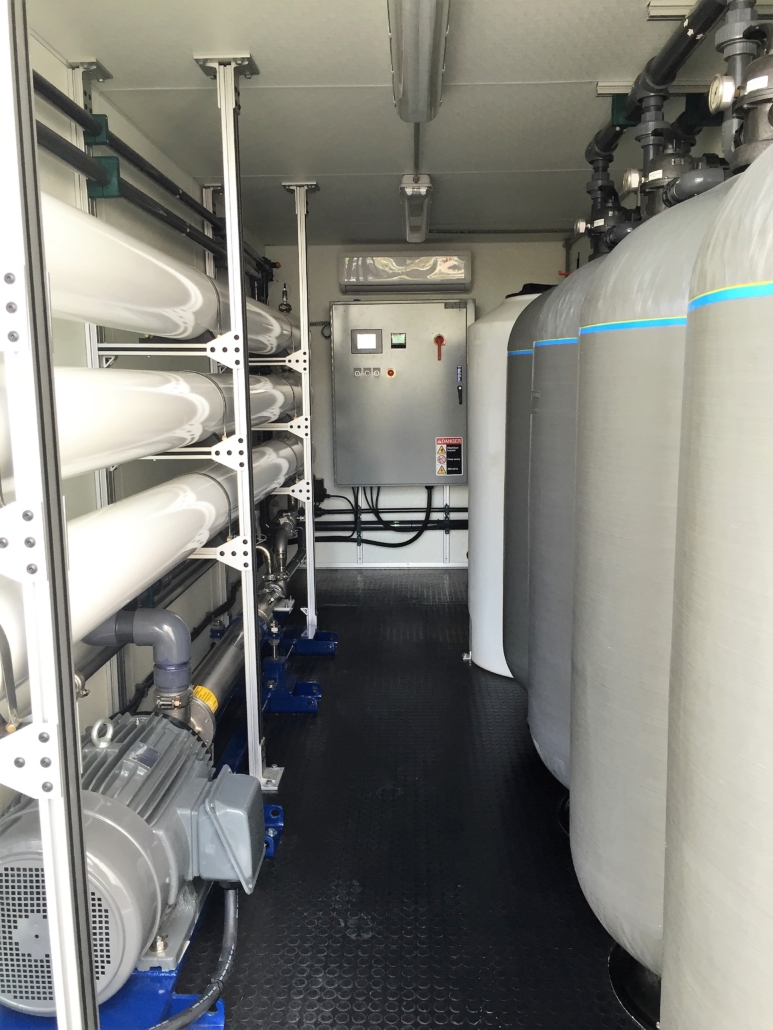Water treatment facilities require efficient, scalable, and reliable reverse osmosis (RO) systems to meet their purification demands. Among the most commonly used configurations are skid-mounted RO plants and containerized RO systems. Each option offers unique benefits depending on operational needs, space availability, mobility, and environmental conditions.
This guide explores the differences between skid plants vs. containerized RO systems, helping businesses and industries determine the best solution for their water treatment requirements.
What Are RO Skid Plants?
RO skid plants are modular reverse osmosis systems built on a compact, open-frame skid that houses key components such as pumps, membranes, and control panels. These systems are pre-assembled and tested before installation, allowing for easy integration into an existing facility.
Key Features of Skid-Mounted RO Plants
- Fully pre-engineered and assembled for plug-and-play installation
- Open-frame design allows for easy access to components for maintenance
- Can be integrated into existing infrastructure with minimal modifications
- Available in customizable sizes to meet different production capacities
- Ideal for facilities with permanent water treatment needs
Advantages of RO Skid Plants
- Cost-Effective Installation – Since the system arrives pre-assembled, installation costs and setup time are reduced.
- Customizable – Can be designed to fit specific flow rates and water treatment needs.
- Easier Maintenance – Open-frame design allows for quick access to components for servicing and repairs.
- Scalability – Additional skid units can be installed as water demand grows.
Best Applications for RO Skid Plants
- Industrial and manufacturing facilities with fixed installation space
- Municipal water treatment plants requiring large-scale water purification
- Agricultural irrigation systems needing consistent and high-capacity water supply
- Power plants and refineries requiring specialized water filtration
What Are Containerized RO Systems?
Containerized RO systems are self-contained water treatment plants built inside a standard ISO shipping container. These units include all necessary components, such as filtration systems, pumps, and electrical panels, making them a fully mobile and turnkey solution.
Key Features of Containerized RO Systems
- Housed inside 20-ft or 40-ft containers for easy transportation and deployment
- Pre-assembled and pre-tested to minimize setup time
- Equipped with climate control, insulation, and protective casing for harsh environments
- Designed for remote locations, emergency water supply, and temporary projects
- Can be configured with solar panels for off-grid operation
Advantages of Containerized RO Systems
- Portability – Can be relocated as needed, making it ideal for temporary or mobile applications.
- Minimal On-Site Installation – Systems arrive fully enclosed and ready to operate, reducing installation time.
- Weather Protection – Built to withstand extreme climates, ensuring durability in remote locations.
- Rapid Deployment – Ideal for disaster relief, military applications, and emergency water supply.
Best Applications for Containerized RO Systems
- Off-grid locations where traditional infrastructure is unavailable
- Emergency water treatment after natural disasters or crises
- Mining, oil & gas, and remote industrial operations requiring mobile water purification
- Construction sites that need a temporary water treatment solution
- Coastal communities or islands with limited access to freshwater sources
Skid Plants vs. Containerized RO Systems: Which One Is Right for You?
When choosing between skid-mounted RO plants and containerized RO systems, it’s essential to consider factors such as mobility, installation environment, and operational flexibility.
| Factor | RO Skid Plants | Containerized RO Systems |
|---|---|---|
| Mobility | Fixed installation, not easily movable | Fully mobile, can be relocated as needed |
| Installation | Requires integration into an existing facility | Arrives pre-assembled and ready for quick deployment |
| Maintenance Access | Open-frame design for easy servicing | Enclosed system with protected components |
| Weather Resistance | Requires an indoor or covered area | Fully enclosed and weather-resistant |
| Use Case | Permanent facilities with high water demands | Remote sites, emergency relief, or mobile applications |
| Customization | Fully customizable to fit facility needs | Standardized container sizes with optional add-ons |
Final Considerations: Making the Right Choice
- Choose RO skid plants if:
- You need a long-term water treatment solution at a fixed location
- Your facility has existing infrastructure for integration
- Custom configuration is essential for your water treatment needs
- Easy maintenance access is a priority
- Choose containerized RO systems if:
- You need a portable and rapidly deployable water treatment unit
- Your operation is off-grid or in a remote location
- You require climate-controlled and weather-resistant protection
- Quick setup and minimal on-site construction are necessary


